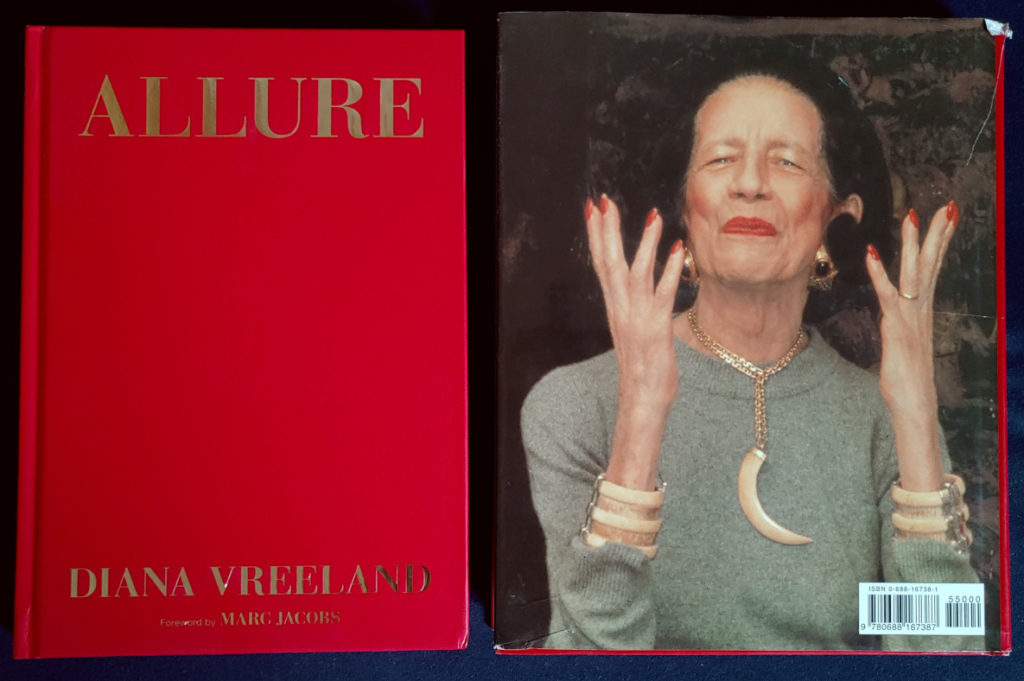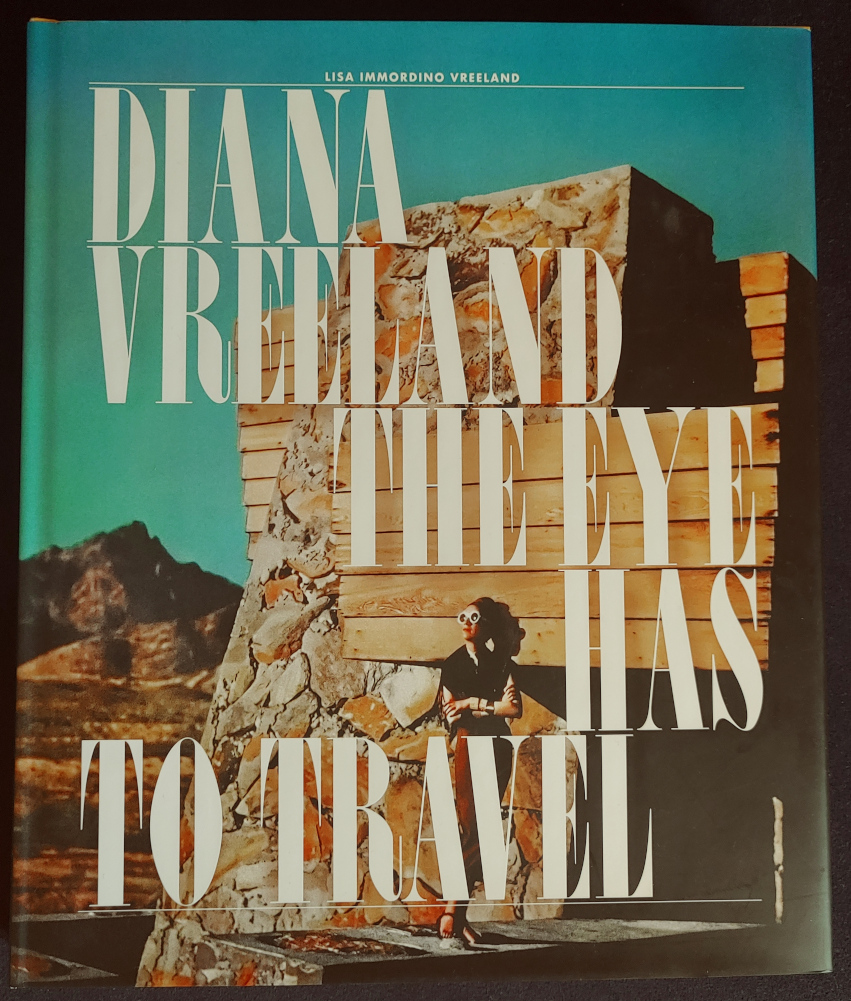“You gotta have style. It helps you get down the stairs. It helps you get up in the morning. It’s a way of life. Without it, you’re nobody”
This quote of Diana Vreeland is my most favourite one. It embodies everything the Italian concept of Bella Figura means and it is the best advice for facing life in general. Even if you are at the centre of a perfect storm, keep your head up high, dust of our imagined crown and walk straight on. Be your best possible self.
In this article we look at three books, one being Diana Vreelands richly pictured autobiography “Allure”, one being her grand-daughter-in-law’s coffee table photo book of Diana Vreelands artistic work “The Eye has to Travel”, and the third being a very good biography of her by Eleanor Dwight, simply named “Diana Vreeland”. Full captions you find at the end of this post. All quotes are from these three books.
“The eye has to travel”, one has to see things, take them in, think about them, build dreams around pictures and colours – this embodies the way Diana Vreeland worked in fashion and shaped what we still see as stylish today. With her it was WHAM, colours, ideas, creativity, style, action…
Looking through the books, viewing the pictures, it is clear how decisively she minted our idea of high maintenance fashion and high living to this day. She’d been in the fashion industry with Harper’s Bazaar and Vogue from 1936-1971 and afterwards worked at the Metropolitan Museum of Art. A long career, half a century of creating the style of the Western World has lefts its mark – on the whole world that is. Everything she touched has a boldness to it.
She never showed fear. Fashion shots under her tutelage from the 1960ies still look modern today, because her eye was an absolute one, like the absolute ear of Mozart or Beethoven for sound. A good example one can see on the front cover of “The Eye Has To Travel”. It was one of the many cooperation’s between Vreeland and photographer Louise Dahl-Wolfe, who created wonderful fashion pictures together. The picture of a model in the wilderness of Arizona, brownish beige black colours perfectly set off against the clear blue sky, looks so modern, it could be on a cover today and not feel outdated. Potentially Louise Dahl-Wolfe and Diana Vreeland could have made a sack of potatoes look like a fashion statement.

Her signature colour was a lacquered red, as shown wonderfully on the front cover of her own book “Allure”. Actually, in reality the tone of Eleanor Dwight’s book cover fits even better for the tone of red that Vreeland loved, but it doesn’t photograph as such and that’s why I only used the back cover of Dwight’s book with Diana Vreeland’s portrait on it. Together, though, they show some of the spirit of the woman. Bold and fearless. As one can see in the picture, Diana Vreeland was not a classic beauty herself. Similar to the Duchess of Windsor she knew she wouldn’t win a beauty contest, but no one could compete in elegance and style and creativity with her. There is an enthusiasm about here that is contagious. A lot of discipline and a lot of energy. She liked big jewellery, also costume jewellery. Elegance was – in her own fashion – mostly not refusal, although she liked to quote that.
She first caught an audience’ eye through her “Why Don’t You” column in Harper’s Bazaar in the 1930s. Whimsy and outlandish “Why Don’t You” advice for a country still ridden by the Great Depression after the stock crash in 1929, like the idea to rinse one’s blond child’s hair with dead champagne or to own diamond rose (brooches) in all sizes. I don’t know how many people outside the circle of the well-to-do read this, but her ideas were seen as funny and witty and not Marie Antoinette like, who is said to have suggested people should eat cake if they had no bread.
The 1930ies were the golden time of the cinema, where dreams of a better life and of social climbing were brought to people being a lifetime away from it. Diana Vreeland caught that notion; the American Dream is very much alive with her.
Looking through those books about her again, she had clear ideas and her very specific way of living and working. Usually, the tale of her firing from the magazines is written about with great indignation by commentors. Working in a corporate environment myself, with budgets and certain need for rules, I do understand that the people in charge might have had enough at a time. Really creative people, charismatic ones, can be very tiring and demanding on those who have to work with them. One tiger person per company is enough, more the company cannot stand and survive, that’s how I call it. I have no special insights about why she was let go – but honestly there might have been a few good reasons. Maybe after being in charge so long, it wasn’t so important how the change looked like, it was important that there was change at all.
Her legacy is a brilliant one, she is an inspiring figure to everybody interested in fashion and an example for strict discipline as to never become sloppy. Diana Vreeland made it look easy to have a career. It is not. The career, being someone and being creative, was important to her, very important. What would have happened, if she hadn’t had to work after her return from England to the USA? Would she still have become the icon we know today? I think yes. Maybe in a slightly different environment, but I doubt she’d stayed at home calmly, in a not too perfect marriage (as we learn from Eleanor Dwight – DV herself never batted an eyelid).
She made it look easy, but she had the determination of a Joan Crawford when it came to her image and her will to succeed. Have the two women known each other? I don’t know. They were contemporaries, they could have. Would they have had something to talk about? Oh yes, I’d love to hear those imagined Diana Vreeland–Joan Crawford dialogues. When I googled both names together, I read that maybe Vreeland quoted Crawford once, but I could not find proof of it, so I will not re-quote.
With Diana Vreeland we have a timeless role model for a successful woman full of optimism who could turn mountains though sheer willpower. An image larger than life, in a positive way a caricature of herself. She made herself an icon.
“Elegance is refusal” – she wrote in her book Allure – I think it was a quote of Coco Chanel that she kind of captured. For her own fashion style, it was not really true, nor for the legacy she created. It is true in another sense, though. It is not elegant to dwell on one’s problems to tell everything to everybody, to complain and so forth. To stay elegant and aloof, it is sometimes required to ignore a few unpleasant things and to stay firm. What might have been a pure fashion statement for Chanel was a way of life for Vreeland.
By the way, I have tried the champagne “Why Don’t You” advice. On myself, not on a child. I had some champagne left from New Year’s Eve and the thought of drinking it or using it for cooking was not a pleasant one for my stomach. I had used beer before on my hair, but I must say champagne works better. The hair gets shiny and quite easy to comb. No wonders are to be expected, but it feels nice and will be repeated when there is a leftover from a party. The spirit of Diana Vreeland has to live on, even if only through little decadent escapes from the daily routine.
All rights to the books belong to:
Vreeland, Lisa Immordino: Diana Vreeland, The Eye Has To Travel, 2011, published by Abrams, 115 West 18th Street, New York, NY 10011, Printed in HongKong, China, ISBN 978-0-8109-9743-1 (Front Cover shown above)
Dwight, Eleanor: Diana Vreeland, 2002, Harper Collins Publishers Inc, 10 East 53rd Street, New York, NY 10022, Printed in Japan, ISBN 0-688-16738-1
Vreeland, Diana (with Christopher Hemphill, new foreword by Marc Jacobs): Allure, 2010, Chronicle Books LLC, 680 Second Street, San Francisco, CA 94107, manufactured in China, (first published by Bulfinch Press /Little, Brown and Company in 1980), ISBN 978-0-8118-7043-6

